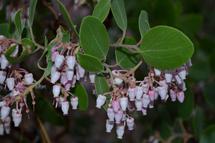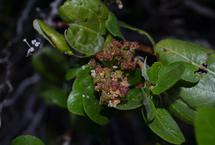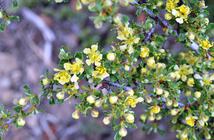saveourplanetearth.com
Call us: (775) 831-1331
Manzanita, Bitterbrush and Tobacco Brush
I’d be willing to guess that one of the most common plants all around the lake is the manzanita. Because it’s so common, we take it for granted, yet it covers itself with delightful clusters of pink blossoms every spring.
Manzanita is the common name for most species of the genus Arctostaphylos. There are close to 110 species of manzanita – the variety of manzanita found in the Great Basin and much of the Sierra Nevada is the Arctostaphylos patula, or greenleaf manzanita.
Manzanita blooms from late winter to early spring, then turns its energy to producing berries for the summer. The fruits look like little green apples. In fact, the name “manzanita” means little apple en español.
The manzanita blossom provides food for butterflies, bees and other insects; then, as it produces its fruit, food for birds, deer and bears.
The wood of the greenleaf manzanita is red, hard and gnarly. Dead manzanita, stripped of its leaves, creates interesting wood sculptures which can be used as bird perches or as ornamental pieces in aquariums.
The hard wood of the manzanita was used by the early settlers and Indians to make utensils and pipes. The leaves were steeped as tea for stomach relief or as a bath for rheumatism, leaves were mashed or chewed to use as a poultice on sores and the berries steeped to make a drink resembling cider.
The blooms of the manzanita are fading but the bitterbrush is exploding with small yellow and fragrant blossoms. Its Latin name is Purshia tridentata. Purshia refers to the genus to which it belongs, in the Rosaceae family, or rose, and stems from the German-American botanist who first described this plant, F. T. Pursh.
Tridentata refers to the three “teeth” on the end of the leaf. Its full common name is Antelope Bitterbrush, signifying its importance as a browse plant for wildlife.
Binomial nomenclature is a formal system of naming species using two parts – the first name indicates the genus, the second name identifies the species within the genus.
There are eight major taxonomic ranks in the hierarchy of biological classifications defining “Life”:
Life – having self-sustaining processes
1. Domain – all cellular life
Domain – all cellular life
2. Kingdom – animal, plant, fungus, Protista, single-celled micro-organisms and bacteria
Kingdom – animal, plant, fungus, Protista, single-celled micro-organisms and bacteria
3. Phylum – general specialization of body plan
Phylum – general specialization of body plan
4. Class – the composition of each class is determined by a taxonomist, and often there is disagreement between various taxonomists
Class – the composition of each class is determined by a taxonomist, and often there is disagreement between various taxonomists
5. Order – determined by taxonomists
Order – determined by taxonomists
6. Family – trees vs ferns, for example
Family – trees vs ferns, for example
7. Genus – determined by taxonomists
Genus – determined by taxonomists
8. Species – group of organisms capable of breeding and producing fertile offspring
Species – group of organisms capable of breeding and producing fertile offspring
We, as amateur botanists, are interested in species, genus and family. Bitterbrush, as we’ve learned, is in the Rosaceae family, along with apples, pears, raspberries, strawberries and others.
The bitterbrush has a long taproot, making it adaptable to drought conditions. They can live to be decades old, some even to more than a century.
Western Indians used the plant medicinally – as a poultice for rashes or insect bites, leaf tea as a tonic for colds or stomach ache, root teas for coughs and fever, and berries as a laxative.
Now is the time to seek out the bitterbrush for its delicate, five-petal flowers but also to appreciate it as a natural medicine cabinet!
The blooms of the bitterbrush last about two weeks, giving way to another yellow blossom that springs from tobacco brush, one of my very favorite flowering shrubs, given its sweet fragrance that floats on the breeze in early June.
A shrub in the family Rhamnaceae, common name tobacco brush or snowbrush, has a single long taproot with a spreading root system, extending to a depth of 6 to 8 feet.
The fruit is a three-lobed capsule, which, when ripe, snaps open to spill the three seeds onto the ground, where they may remain for over 200 years before sprouting.
The seed has a very hard outer shell, delaying germination. It can’t be penetrated except by dramatic means, usually wildfire, therefore it stays dormant, waiting.
The plant was also used by Indians as a tea for treatment of colds, fevers and the flu.
This would be a good time to get out on even a short stroll through the woods, and to perhaps ponder the marvels of these three common plants.
Manzanita flower.
Bitterbrush flower.
Tobacco brush fruit.





